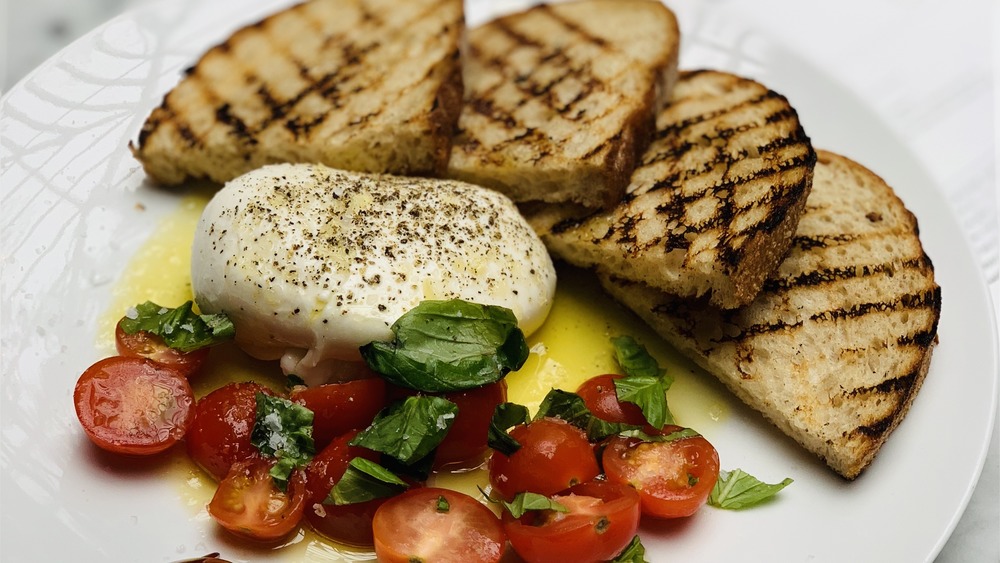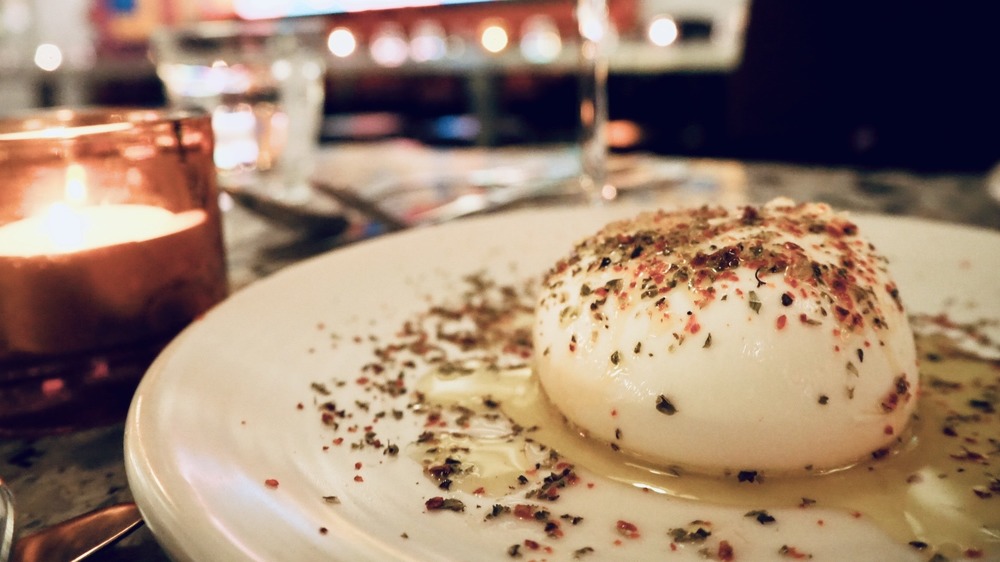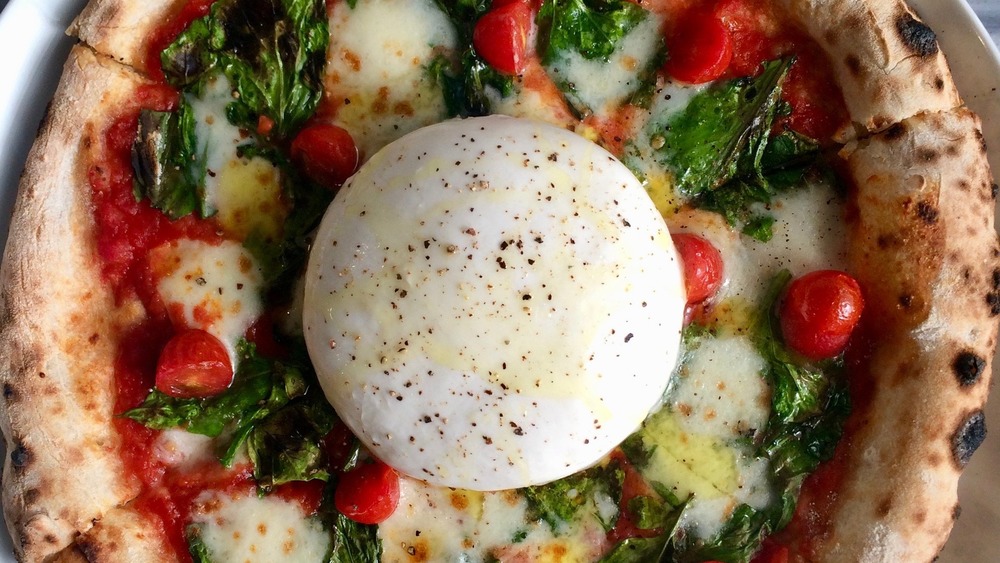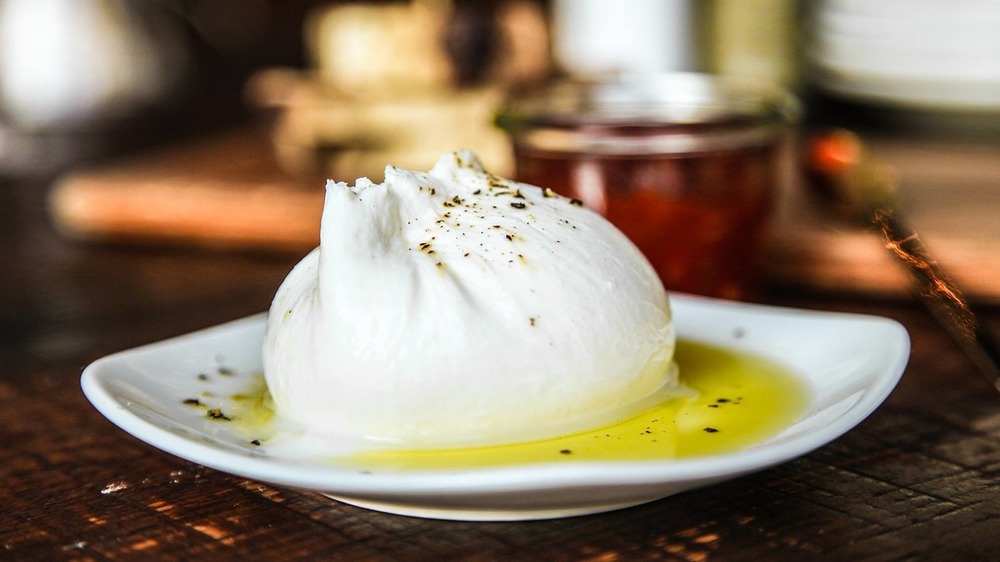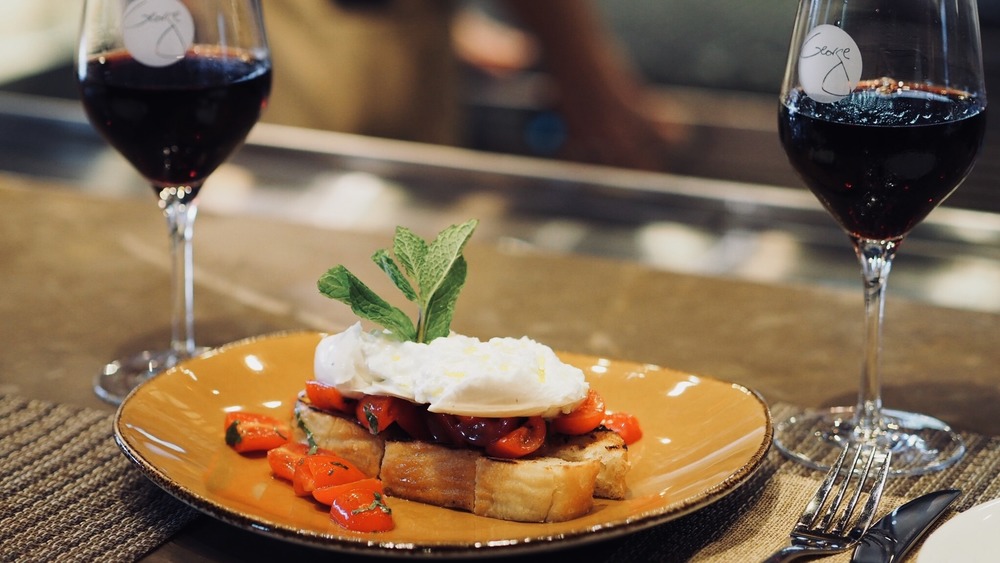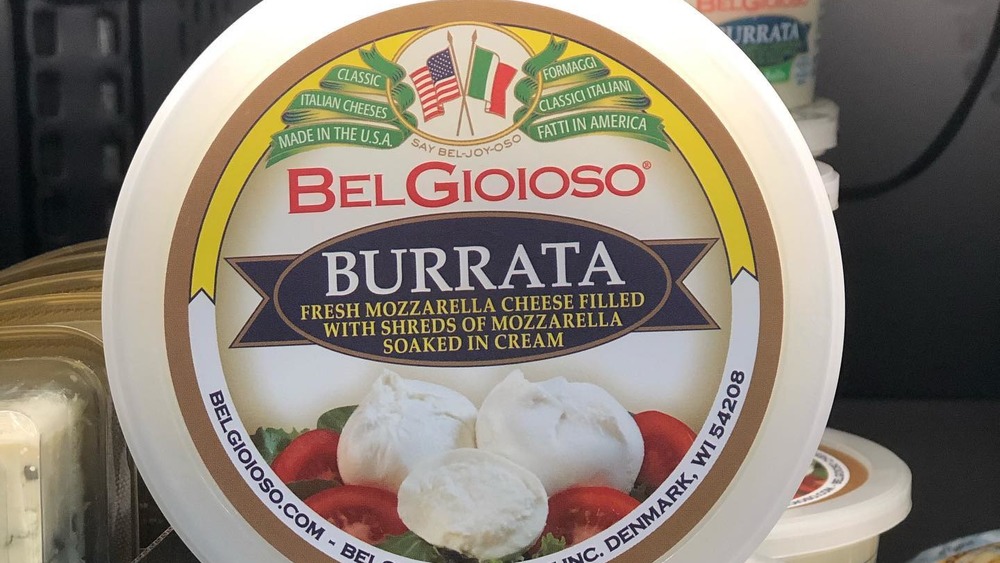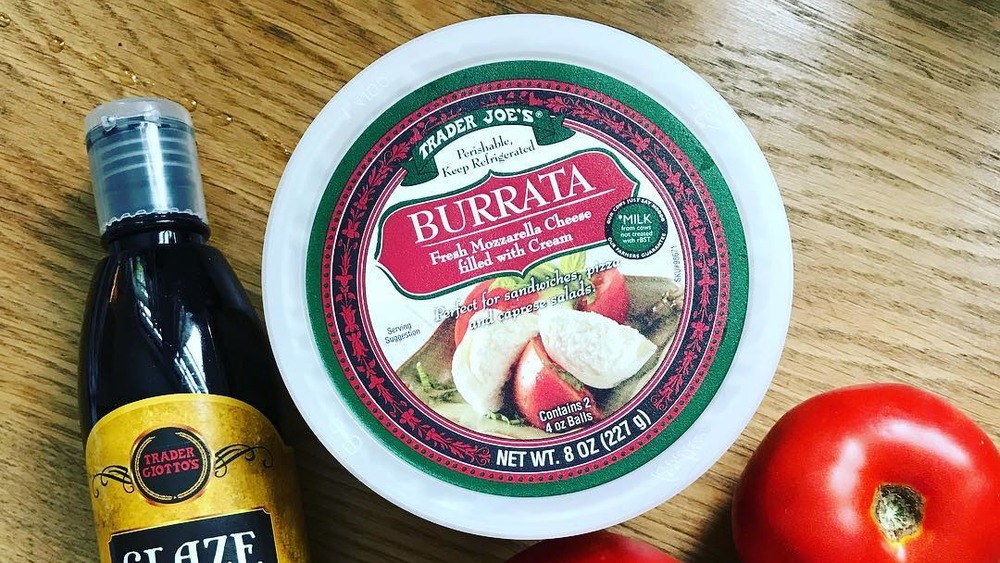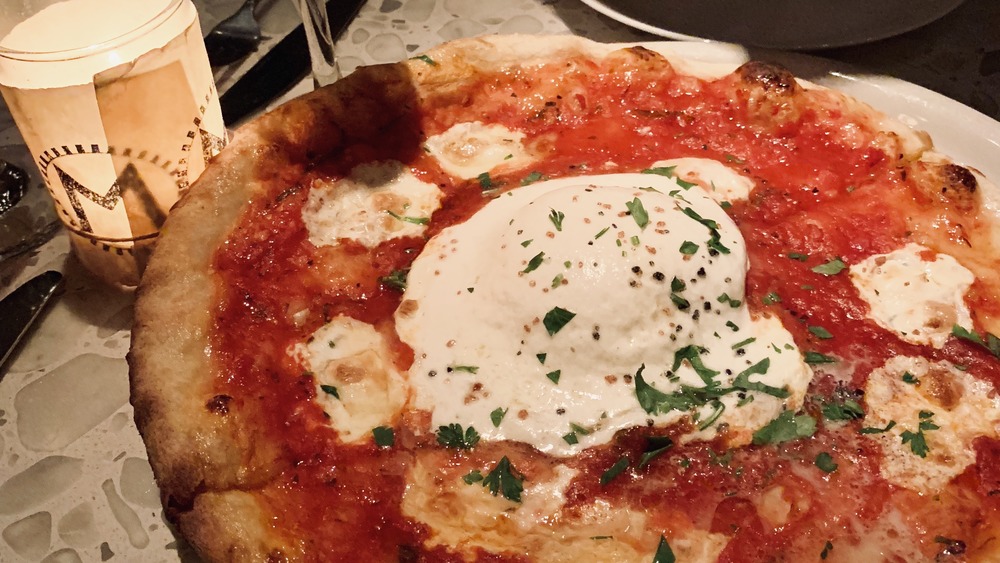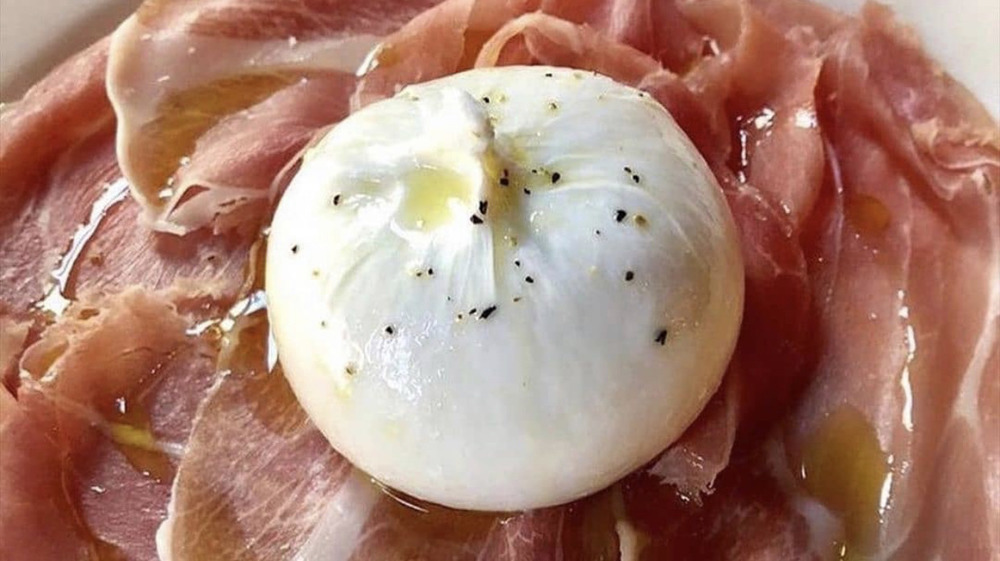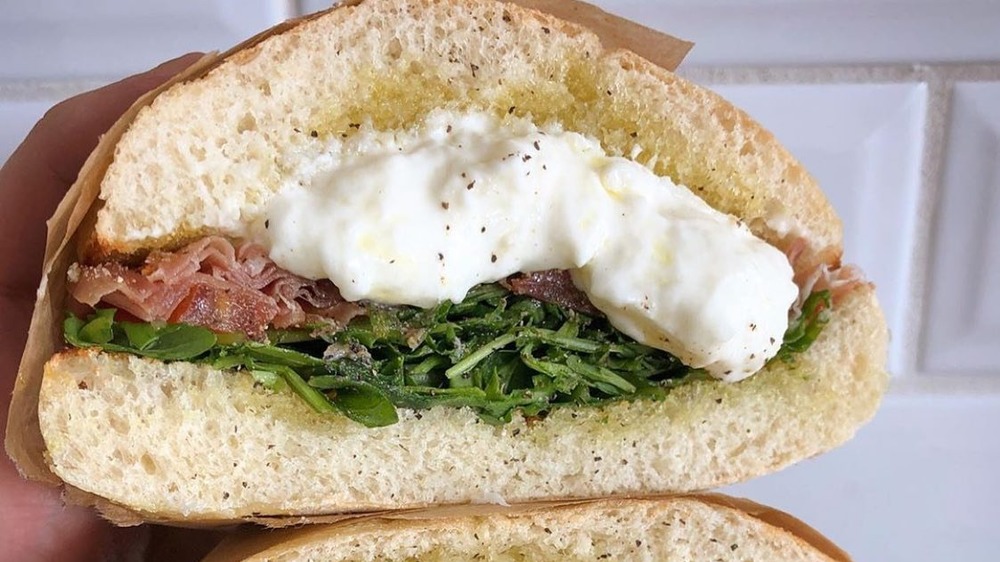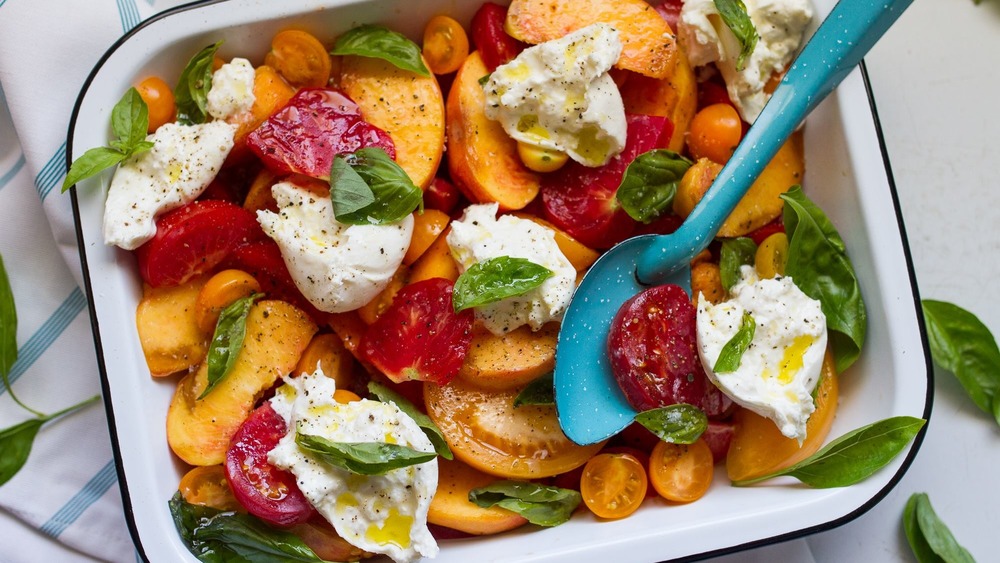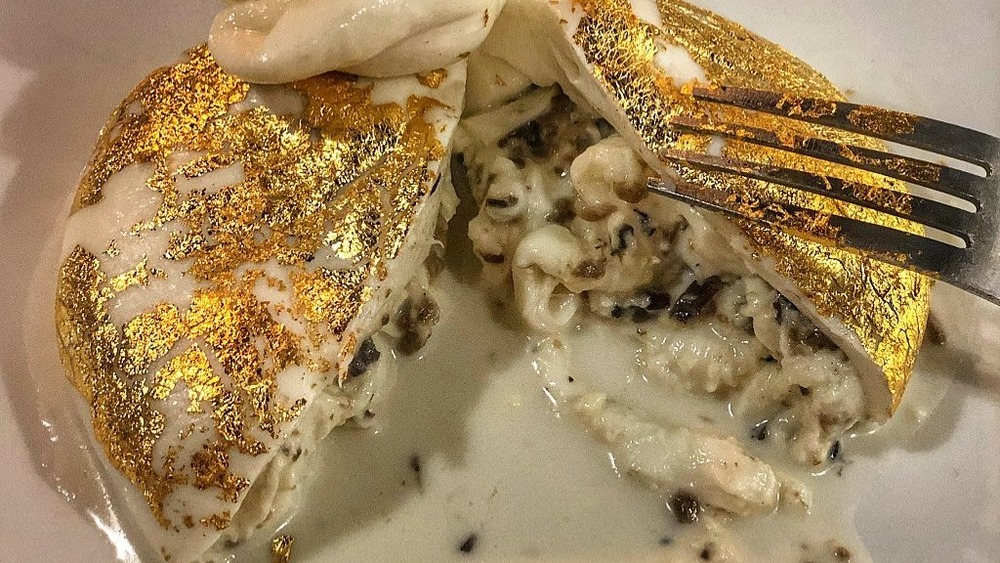The Untold Truth Of Burrata Cheese
Burrata is here, and it is here to stay. Few things have made such an everlasting impact on the food industry as we know it today more so than the Italian cheese that swept the United States just a few short years ago. We've never been known to shy away from a nice, sharp cheddar, or turn down a crumbly goat cheese, but no cheese has held a candle to the allure of burrata.
There's just something about slicing that knife through a big ball of cheese to reveal a lusciously creamy center that gets our taste buds going. Delicious on its own, this indulgent 'it' cheese pairs wonderfully with a fresh heirloom tomato and cold-pressed olive oil or scooped up on a nice crunchy loaf of bread with some salty prosciutto.
How is it that a cheese that has been around since the early 20th century is only now seeing its glory days at the forefront of culinary innovation? Becoming nothing short of a global phenomenon, it now sits atop many a restaurant's menu, like a headline beckoning you to come on in and try it for culinary glory. Sit back, relax, and join us on this cheese journey as we explore the untold truth of burrata. We are certain that we'll make a believer out of you, too. It's that good, we promise.
What exactly is burrata?
Before we can forge on, we must set the record straight. Mozzarella and burrata are not one and the same. Sure, it's made from the same buffalo milk as a buffalo mozzarella, but the two are entirely different. Per Kitchn, burrata translates to "buttered" in Italian, and buttery it is indeed. The exterior is a firm shell, similar to traditional fresh mozzarella, but which then opens to reveal a luscious center of curd and fresh cream. While it doesn't compare in taste to ricotta, the center is of similar smooth consistency.
According to Castello, the art of making burrata is quite labor-intensive and requires a certain level of skill to make right, accounting for its often high price tag on any restaurant's cheese menu. It's created by hand using raw or pasteurized milk that is heated until it curdles. This process can be slow, made even more deliberate considering that the curdle is hand pulled to the desired consistency.
The stretched curd, known as stracciatella cheese, is then formed into a small ball and packed with thick cream and scraps of leftover mozzarella before workers tie it shut at the top. Given its delicate nature, burrata is best served within a few days of its creation. Anything after would result in a different texture and could compromise its taste and the diner's overall experience.
Where did burrata originate?
Burrata's origin story and evolution are as wonderfully complex as the cheese itself, which came to be in the Puglia region of Italy in the 1920s. Located in Southern Italy, the first burrata was created in the farming town of Andria in Murgia. According to the BBC, while it was likely created on a farm, it was a beloved local cheesemaker, Lorenzo Bianchino Chieppa, who produced the first burrata for consumer consumption. It's since been assumed that burrata was created from leftover cream and mozzarella as a way to be more mindful in food production. That is, burrata was likely created to make good use of cheesemaking leftovers.
The first clearly traced and documented roots of burrata come in 1931 when the cheese was officially listed as a local product of Andria in an Italian recipe book, the BBC reports. Burrata was solely available in this region until the 1950s when regional cheese factories began producing it. These newfound producers of the cheese led to it then becoming more readily available in other parts of Italy.
The Puglia region is still home to cheesemongers and dairy farmers churning out the cheese to this very day, but now in much higher numbers given the worldwide demand. In 2016, burrata di Andria became a protected geographic indication product, establishing strict premium standards for this variety of burrata, even as mass commercial production made it more and more popular.
How did burrata get so popular?
In 2018 alone, the BBC reports, over $50 million worth of burrata was produced in Italy and exported all around the world, ending up in high-end markets and restaurants across Asia, North America, and beyond. That's a pretty staggering number considering the fact that just decades before, the name was hardly ever uttered outside of Italy. Burrata first reached the shores of America when it was exported from Italy in the late 20th century. Italian-Americans predominantly consumed the cheese in the New York region, and it was rarely heard of outside their culture.
Mimmo Bruno, the founder of Di Stefano cheese, is credited with producing the first burrata in the United States (via KCET). Born in Puglia, Italy, Bruno immigrated to the states where he opened his first cheese factory, Tutto Latte, in Los Angeles in 1996. While at first they only produced cheeses more familiar to Americans, like ricotta and mascarpone, it was Bruno's fondness for his childhood spent in Southern Italy that inspired him to introduce the American palate to burrata.
At first, it didn't quite go as planned, as restaurants were hesitant to come on board with something totally foreign to their customer base. Then, famed chef Nancy Silverton took a chance on the cheese and added it to her restaurant's menu. A week later, as the Los Angeles Times reports, restaurant critics keyed into the new, delicious cheese and the rest is history.
How do restaurants serve burrata?
Burrata has now made its way onto menus across the globe, and it's not just limited to the appetizer section. As Hoodline reports, Cotogna in San Francisco uses the delicate cheese on a squash blossom pizza, while Yolan in Nashville serves it alongside caviar (via Eater Nashville).
While versatile, some of the very best interpretations of burrata allow the cheese to shine on its own. Master Sommelier George Miliotes, who helped open Seasons 52 and is now the owner of the critically acclaimed Wine Bar George in Lake Buena Vista, Florida, happens to serve two standout burrata dishes alongside over 150 wines available by the glass, bottle, and even ounce.
A natural pairing for wine, they offer a burrata appetizer, served simply with seasonal tomatoes and grilled bread, as well as a burrata avocado toast, which he notes is often their best seller for their weekend brunch (via AllEars.net). Miliotes tells Mashed: "What is better than cheese wrapped cheese with a little cream? You can pair burrata with every wine there is as the richness of the cheese and cream will offset the tannins in red wines and the crispness in white." When Wine Bar George first opened in 2018, Milotes said, many customers were unfamiliar with burrata and questions often arose for waitstaff. As burrata's risen in popularity rapidly, those questions are now fewer and farther between.
While burrata's shelf life is short, its uses are endless
Since burrata is free of any preservatives and additives, it's best consumed right away. While its uses are endless, you must first make sure that you're getting the best possible flavor out of this cheese. Unlike its sibling cheese mozzarella, burrata is best when served at room temperature. This means that you should remove it from your refrigerator about 30 minutes before serving and allow it to warm up.
While we love it served with a simple extra virgin olive oil and tomatoes, there are never-ending recipes for the cheese, including ultra-creamy mac and cheese. The cow's milk used to make burrata is less fatty than other dairy varieties like sheep's milk, resulting in a much different flavor profile and making it a wonderful new addition to many dishes.
For instance, consider the grilled cheese sandwich. Forget your mother's grilled cheese made with other cheeses. Instead, substitute that processed cheese with burrata for an elevated version of the childhood staple. Burrata also can be used for bruschetta, or try simply pairing it with peaches and figs. Burrata can also quickly add a unique and savory depth of flavor to any pasta dish, like atop a rigatoni with basil pesto. When combined with other quality ingredients, it is a no-fuss way to serve a memorable dish that allows the flavors to shine.
You don't need to visit a fancy cheese shop or restaurant to try burrata
There's clear and evident craftsmanship that goes into making burrata. With the growing demand for this cheese, companies have been quick to take advantage of its popularity and begun producing their own varieties of burrata for the masses. While it's always best and freshest when consumed right away, whether you've gotten your burrata from a specialty cheese shop or a restaurant that makes it in-house, there are other ways to satisfy your burrata craving.
As it turns out, burrata is now widely available in your local supermarkets. Per Dairy Network, popular cheese distributor BelGioso introduced a store ready version of burrata in 2006. To bring authenticity to its customers, they enlisted the help of Mimmo Bruno to develop and perfect their version. Trader Joe's also sells burrata that contains 8 ounces of the lust-worthy cheese for under five dollars, making it one of the more affordable options out there (via Houston Food Finder). Do note, however, that most store-bought containers must be consumed within 24 hours of opening in order to not compromise the quality and taste of the precious burrata inside.
Burrata is bomb on pizza
There's been one sub-trend that has emerged from the popularity of burrata that really takes this ingredient into the culinary stratosphere: the burrata topped pizza. Because, really, what's better than a mozzarella-topped pizza with a big ball of more cheese on top? It's since become a mainstay on many Italian-inspired menus and has even been offered as an add-on at many local pizzerias.
New York City's Macchina, a cozy Manhattan restaurant serving Italian fare, was one of the first to bring us to cheese heaven with their burrata topped Margherita pizza. When they opened in 2018, the visual stunner soon became a sought-after item by critics and exploded thanks to social media. The Insta-worthy creation has since become their signature item landing them national and even global attention (via Insider).
You can also attempt to create this pizza for yourself at home. Keep in mind that the burrata isn't cooked on top of the pizza in the oven, but rather added at the very end of the process. To ensure it's of proper consistency and will spread easily on the pizza, make sure the burrata is as close to room temperature as possible when you add it to your pizza.
There's an entire Instagram accounted dedicated to burrata
There's something so inherently satisfying about watching a stranger cut open a ball of burrata cheese to reveal its rather mysterious contents. New York City-based Victoria Varone took advantage of this fascination when she launched an Instagram account dedicated entirely to the cheese, @Burratagram. A space scientist by day, the passionate foodie tells Mashed that "It was really just the fact that I fell in love with burrata and recognized an opportunity to start something fun. I saw the types of comments that were left on burrata posts on Instagram and, being Italian-American myself, I know how passionate people are about Italian food. So, I took a chance on it, and here we are." The account now boasts over 100,000 members, who have since deemed themselves the #burratasquad.
The content is submitted by the #burratasquad and shared across the Instagram platform. Valone isn't exactly surprised by the reaction from thousands of strangers on this cheese-filled internet niche. She tells Mashed: "Food accounts are extremely popular on Instagram. Italian food accounts, maybe even more so, which isn't surprising since Italian food is well-loved all around the world. Then when we put the focus on burrata, you'll realize (by the types of comments and responses on burrata pictures and videos) that it's a food that evokes an air of luxury and indulgence, of being the best thing you can get. It's the ultimate #foodporn."
There is a restaurant called the Burrata House
You can safely call something a phenomenon when a restaurant dedicated entirely to the food opens its doors. Welcome to the Burrata House. Since opening in 2018, Burrata House is where you can live out all your cheese-filled fantasies at this restaurant in Culver City, California. In an attempt to bring accessible and great Italian food to the masses, founder Antonello Dato, a burrata lover himself, placed the focus on the hero of cheeses for this now mega-successful concept. As he told Spectrum News 1, "It's the right amount of texture, flavor, and creaminess to every single dish. It's perfect." Perfect, it is.
According to Do LA, the Burrata House menu is chock full of options celebrating the Italian import, including a panini layered high with the creamy cheese and salty prosciutto to balance it all out. Bowls are also popular amongst Burrata House patrons and feature cured meats and fresh locally sourced vegetables that are then topped with a generous ball of burrata.
Moscow is absolutely obsessed with burrata
Burrata's popularity in America is palpable, but another country is not far behind in their obsession with the cheese. The fast-paced city of Moscow, Russia is known for its rich history, bustling culture, and rich food scene. It also happens to be a place with a newfound affinity for burrata cheese. Always on the cutting edge of food trends, Moscow's fascination with the cheese could be attributed to the popularity of cream-based dishes in classic Russian cuisine. As Russia Beyond reports, people throughout the country already love to put sour cream in practically everything.
In 2014, the United States and the European Union placed an embargo on Russia that banned the import of dairy, produce, and more from the US and EU (via The Guardian). As a result, many Russians had to learn how to produce their own cheese, including burrata.
This cheese soon found its way onto the menu of high-end restaurants throughout the nation and became a focal product for smaller producers. Roads and Kingdoms shares a theory on why burrata took off in just such a manner. Russians have an affinity for not only adopting trends but making them their own. Burrata is extremely versatile and therefore can be interpreted in never-ending ways, making it perfect for Moscow's food culture. Since then, cheese shops have popped up all over the country and the dish has landed on the menus of many restaurants, including Syrovarnya, which makes and sells its own cheese.
You could try a 22k gold covered burrata
While burrata's humble origins began in the farmlands of Italy, there's a certain sense of opulence now associated with this rich, creamy cheese. One chef took this a step further using good, old-fashioned shock and awe. Out of a desire to impress his well-to-do VIP clientele, Chef Giuseppe introduced burrata covered in edible 22-carat gold on his menu at Italian restaurant Cinque, located in Dubai, already the land of high rollers and ultra-high buildings (via LuxuryLaunches).
The dish features a ball of burrata that is coated in edible gold and named, of course, the Gold Sheikh Burrata. It's now become a mainstay of the menu since its introduction in 2019. As Chef Giuseppe tells Time Out Dubai, "It has become one of our signature dishes and favourite of all our regular guests not to mention one of our most frequently requested, so we decided to keep it on the menu."
Imitation would soon follow this particular innovation. Handcrafted pasta spot and Michelin star restaurant Marea Dubai, started selling their own version of gold burrata in 2020. Perhaps in an attempt to one-up its competition, they fly their burrata in from Southern Italy and coat it in 24-karat gold leaves. Sorry, Shakespeare, all that glitters is, indeed, gold.
